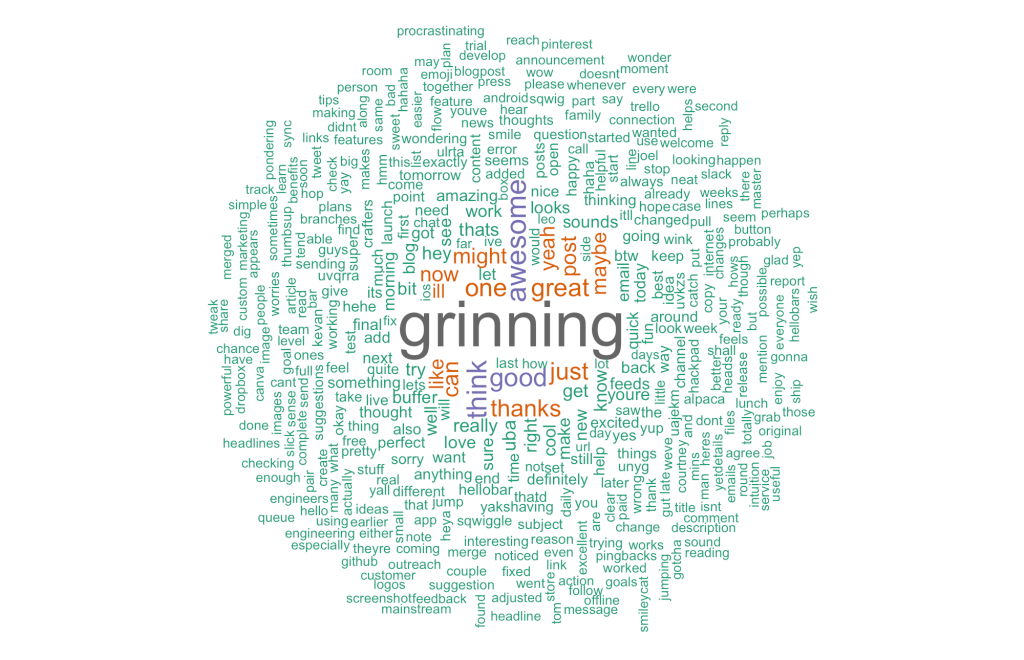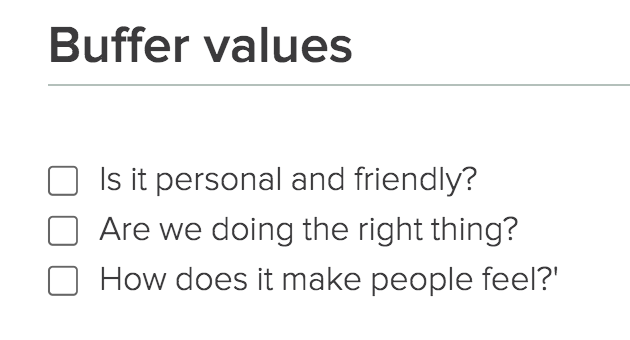I’m pretty big on words.
As Buffer’s content crafter, I guess that kind of comes with the territory. However, I’m not alone on this. Words are an extremely valuable component to the way we get work done at Buffer. As a distributed team, the words we use in our communication with each other carry extra significance. As a company focused on culture and customer support, the words we use are vital to getting across our message in the most accurate, positive way.
As such, we’ve developed a bit of a Buffer language.
The words and phrases we use most often at Buffer slowly but surely become second nature. We drop “keen” and “intuition” into our emails as naturally as can be. We bring our Buffer language into our homes, trying to “mastermind” and “sync” with our loved ones. And the more we use these words, the stronger our culture becomes.
What are these phrases exactly? And how do they support the way we view culture? I’m excited to give you an inside look. Keep reading to see the 10 most common Buffer words and phrases.
First off, a review of Buffer culture.
To add a little context to this Buffer language, I thought I’d start by sharing the 10 Buffer values that make up our company culture. Here’s the slide deck with a breakdown of all ten.
As we go through Buffer language, I’ll point out which elements of culture relate to which words. If you see any values I may have missed, let me know in the comments.
Here we go…
1. “How does this make you feel?”
The question might sound quite obvious. And yet, it’s a very different question than, say, “What do you think?” or “What do you like?”
Focusing on someone else’s feelings—as opposed to their thoughts or personal tastes—adds a deeper layer of empathy to the discussion. It shifts the focus from the item or task or object and places it onto the person.
It feels great to be asked how you feel.
We’ve noticed that this type of empathic question is helpful not only in our communication with each other but also in our communication with Buffer users. When we focus on feelings, responses skyrocket. It would seem people are more inclined to share when you tap into feelings. Is it because one’s feelings can’t be second-guessed? I’d love to know what you think about this—er, rather, how you feel. :)
Buffer values: Empathy, listening
2. “We’re keen to get to the bottom of this”
I don’t believe I had ever used the word “keen” before I joined Buffer. But now, it’s everywhere!
The word most often pops up when we’re talking about our eagerness to tackle a problem or see something come to fruition. Rather than say, “We’re excited to find out what’s broken here!” or “We’d love to see the results from this,” we opt for keen.
You might be familiar with the word “keen” as a way to express something clear and finely tuned—like a keen eye or a keen insight. We use the less well-known definition (but quite common in British English): enthusiasm and excitement.
This makes a world of difference in our emails. Keen makes it so that we clearly express our genuine interest in a topic, without resorting to any cliches or happy talk that can either come across as white noise or disingenuous. We aim to mean what we say, and we’ve found that keen is the perfect word to express our eagerness.
Buffer values: Clarity, positivity
3. “What is your intuition on this?”
Have you ever asked anyone for their intuition before?
We love asking for intuition because it gives the other person an opportunity to share an opinion without feeling a need to have the “right” answer. You can speak without expertise. You can speak from experience.
We value being a “no ego” doer, and part of that value is to communicate with humility. Intuition is a humble alternative to an authoritative answer.
Buffer values: Be a “no ego” doer
4. “I’ve found that …”
None of us are right all the time. There’s a good chance even that I’m wrong more often than I’m right. We celebrate the opportunity to grow with self-improvement and progress, which is why we often seek to avoid concrete, authoritative, no-doubt-about-it statements.
Instead, we speak from experience. “I’ve found that” is our way of letting someone know our opinion in the most open, conversational way possible. It keeps the conversation going, and it allows the other person to make decisions based on our input—rather than being told what to do.
An aspect of the “no ego” value at Buffer is to let other people have your best ideas. “I’ve found that” gives all the necessary information to someone and lets them make the ultimate decision, one that can be their own.
Related words/phrases:
“Maybe we could …”
“I wonder …”
Buffer values: Be a “no ego” doer, let others have your best ideas
5. Awesome, amazing, and other superlatives
“Awesome” is in our genes at Buffer. We’ve even named a plan after it! Our value to default to positivity and happiness often leads to a default response of “Awesome!” or “Amazing!” We all seem to be genuinely happy people, and “awesome” and “amazing” are our battle cries. We’re also big fans of exclamation points, smiley faces, and emoji at Buffer (they figure prominently in this word cloud of our Slack conversations). But you might have guessed that. :)

Of course, being positive in email is a huge advantage. Because the tone of email can be hard to read, you must be absolutely clear of your intentions. There’s little doubt about tone when emails include “awesome” and “amazing” and other super-positive words.
Related words/phrases:
Yay!
Sounds good to me!
Great work!
Good stuff!
Buffer values: Positivity and happiness, clarity
6. “Inspiring!”
We tend to talk a lot about inspiration at Buffer. We act out our value of self-improvement on a daily basis, often trying new improvements based on the experiences of others. Every part of the Buffer product—from support to blog and everything in between—owes a debt of gratitude to the amazing sites and resources that teach us daily.
So it’s no surprise that the word “inspire” comes up regularly in communication.
Inspiration touches on so many different Buffer values. Self-improvement is a big one. Also, inspiration owes a bit to listening, reflection, gratitude, and positivity. Choosing to be aware of other people and responding with gratitude to give credit where credit due is essential to the way we think about inspiration at Buffer.
Buffer values: Self-improvement, listening, reflection, gratitude, positivity
7. “Let’s sync”
Though we’re a team of 24 spread across the globe, we end up talking to one another quite a lot. We call these meetups “syncs.”
I suppose we could call them most anything really, but there is a special feeling about the word sync. To sync with someone, you imagine getting on the same page with them. To get on the same page with someone, you imply a sense of equality.
In a meeting, someone’s in charge and a hierarchy is present. With a sync? It’s just a couple of teammates getting up to speed with one another.
We tend to use the word “sync” a lot, as evidenced by this word cloud of our daily achievement emails (via idonethis).

Related words/phrases:
Mastermind (a type of mentoring we all do)
Buffer values: Be a “no ego” doer, positivity, clarity
8. “Would you be up for … ?”
If we need to ask a favor of someone, our go-to question isn’t “Can you do this for me” but rather “Would you be up for this?” We like to put the focus on the other person, making it as clear as possible that we value their time and energy and giving them every opportunity to say no if they need to.
“Would you be up for” seems to accomplish this goal pretty well because it is entirely others-focused. There’s no pressure for a forced yes. And the whole concept of “being up” for something is rather invigorating, wouldn’t you say?
Buffer values: Empathy
9. Here’re, it’d, and other fun contractions
There is no such thing as a bad contraction. This is the code I go by at Buffer (and one where I’m sure English teachers and I might disagree).
Here’s the thing about contractions: They’re conversational. They’re casual. They’re fun.
We aim to be approachable with our communication with teammates and our communication with users. A properly placed contraction—especially one you don’t see all that often—can easily do the trick. Here’re a few of the more unusual ones I’ve used so far:
Here’re = Here are
There’re = There are
It’d = It would
I’d’ve = I would have
Buffer values: Positivity and happiness
10. “Buffery”
I think we’ve come full circle by this point! “Buffery” is our behind-the-scenes term for the overall way that we communicate with users, be it via the product, in the app, over email, etc.
“Buffery” encompasses all our Buffer values, making sure that the message we’re portraying is in line with the way we want to make people feel. It often serves as a reminder to make things fun, too! We love it when positivity and happiness radiate from what we write.
In fact, each of our specs for future product enhancements or experiments includes a checklist of Buffer values.

Buffer values: All of them!
Which words/phrases resonate the most in your workplace?
These aren’t the best or right words, of course—they’re just some of the phrases that many of us have adopted to communicate more kindly and gently as a team.
I’d love to hear your thoughts about the “Buffer language” we’ve developed as well as what words you hear the most in your own office. Let’s talk more about words in the comments!
Image credit: revbean
Try Buffer for free
190,000+ creators, small businesses, and marketers use Buffer to grow their audiences every month.



